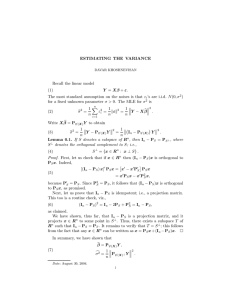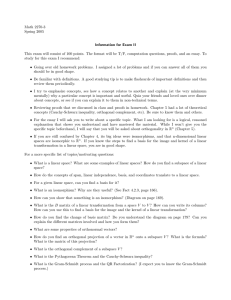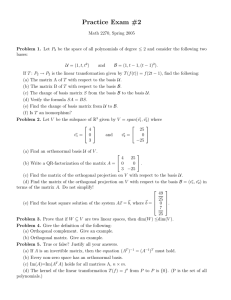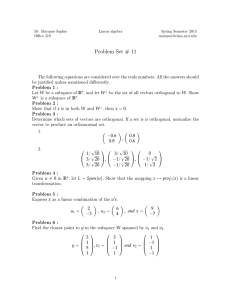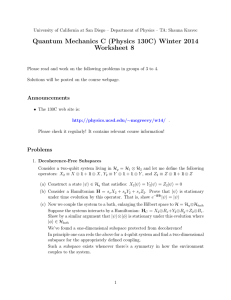LEAST-SQUARES ESTIMATORS IN LINEAR MODELS 1. The General Linear Model Let
advertisement
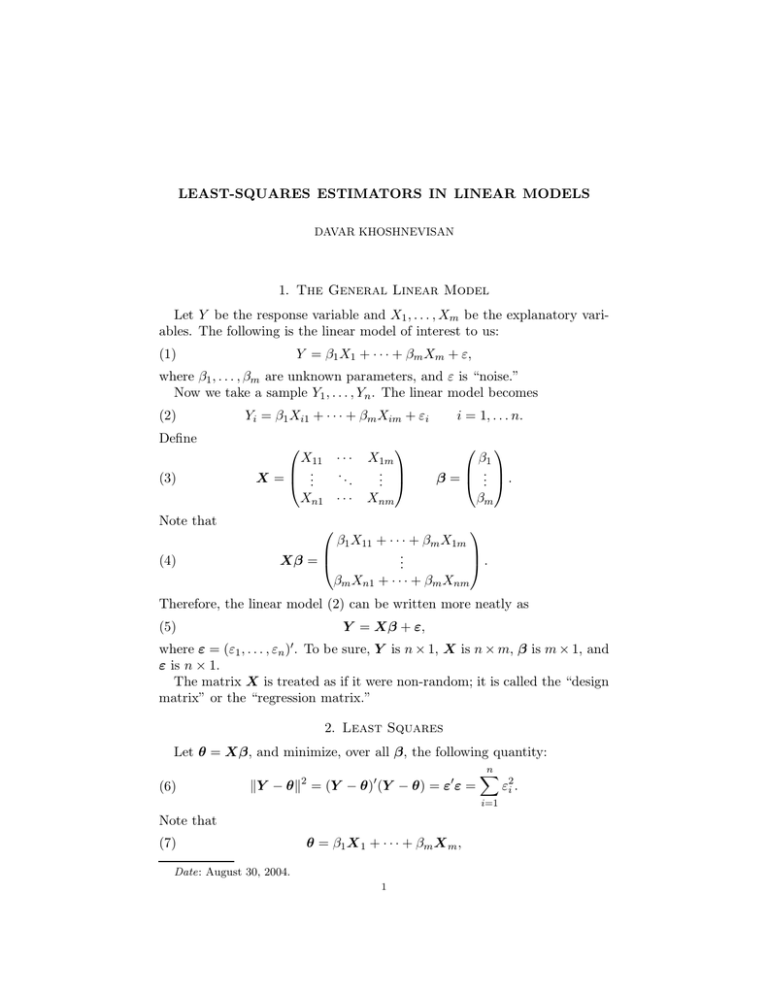
LEAST-SQUARES ESTIMATORS IN LINEAR MODELS DAVAR KHOSHNEVISAN 1. The General Linear Model Let Y be the response variable and X1 , . . . , Xm be the explanatory variables. The following is the linear model of interest to us: Y = β1 X1 + · · · + βm Xm + ε, (1) where β1 , . . . , βm are unknown parameters, and ε is “noise.” Now we take a sample Y1 , . . . , Yn . The linear model becomes (2) Define (3) Note that (4) Yi = β1 Xi1 + · · · + βm Xim + εi X11 · · · .. .. X = . . Xn1 · · · X1m .. . Xnm i = 1, . . . n. β1 β = ... . βm β1 X11 + · · · + βm X1m .. Xβ = . . βm Xn1 + · · · + βm Xnm Therefore, the linear model (2) can be written more neatly as (5) Y = Xβ + ε, where ε = (ε1 , . . . , εn )0 . To be sure, Y is n × 1, X is n × m, β is m × 1, and ε is n × 1. The matrix X is treated as if it were non-random; it is called the “design matrix” or the “regression matrix.” 2. Least Squares Let θ = Xβ, and minimize, over all β, the following quantity: n X kY − θk2 = (Y − θ)0 (Y − θ) = ε0 ε = ε2i . (6) i=1 Note that (7) θ = β1 X 1 + · · · + βm X m , Date: August 30, 2004. 1 DAVAR KHOSHNEVISAN Y- θ Y 2 θ C (X) b of Y onto the subspace Figure 1. The projection θ C (X) where X i denotes the ith column of the matrix X. That is, θ ∈ C (X)—the column space of X. So our problem has become: Minimize kY − θk over all θ ∈ C (X). b ∈ C (X) A look at Figure 1 will convince you that the closest point θ is the projection of Y onto the subspace C (X). To find a formula for this projection we first work more generally. 3. Some Geometry Let S be a subspace of Rn . Recall that this means that: (1) If x, y ∈ S and α, β ∈ R, then αx + βy ∈ S; and (2) 0 ∈ S. Suppose v 1 , . . . , v k forms a basis for S; that is, any x ∈ S can be represented as a linear combination of the v i ’s. Define V to be the matrix whose ith column is v i ; that is, V = [v 1 , . . . , v k ]. (8) n Then any x ∈ R is orthogonal to S if and only if x is orthogonal to every v i ; that is, x0 v i = 0. Equivalently, x is orthogonal to S if and only if x0 V = 0. In summary, (9) x ⊥ S ⇐⇒ x0 V = 0. Now the question is: If x ∈ Rn then how can we find its projection u onto S? Consider Figure 3. From this it follwos that u has two properties. (1) First of all, u is perpendicular S, so that (u − x)0 V = 0. Equivalently, u0 V = x0 V . LEAST-SQUARES ESTIMATORS IN LINEAR MODELS 3 x x-u u C (X) (2) Secondly, u ∈ S, so there exist α1 , . . . , αk ∈ Rk such that u = α1 v 1 + · · · + αk v k . Equivalently, (10) u = V α. α0 V 0 V Plug (2) into (1) to find that = x0 V . Therefore, if V 0 V is invertible, then α0 = (x0 V )(V 0 V )−1 . Equivalently, (11) u = V (V 0 V )−1 V x. Define (12) PS = V (V 0 V )−1 V 0 . Then, u = PS x is the projection of x onto the subspace S. Note that PS is idempotent (i.e., P2S = PS ) and symmetric (PS = P0S ). 4. Application to Linear Models Let S = C (X) be the subspace spanned by the columns of X—this is the column space of X. Then, provided that X 0 X is invertible, (13) PC (X) = X(X 0 X)−1 X 0 . b of θ is given by Therefore, the LSE θ b = PC (X) Y = X(X 0 X)−1 X 0 Y . (14) θ b So X 0 X β b = X 0 Y . Equivalently, This is equal to X 0 β. b = (X 0 X)−1 X 0 Y . (15) β
